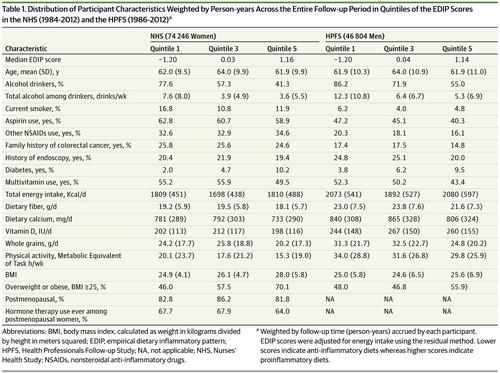当前位置:
X-MOL 学术
›
JAMA Oncol.
›
论文详情
Our official English website, www.x-mol.net, welcomes your feedback! (Note: you will need to create a separate account there.)
Association of Dietary Inflammatory Potential With Colorectal Cancer Risk in Men and Women.
JAMA Oncology ( IF 28.4 ) Pub Date : 2018-03-01 , DOI: 10.1001/jamaoncol.2017.4844 Fred K Tabung 1, 2 , Li Liu 1, 2, 3, 4, 5 , Weike Wang 1, 2 , Teresa T Fung 1, 6 , Kana Wu 1 , Stephanie A Smith-Warner 1, 2 , Yin Cao 1, 7 , Frank B Hu 1, 2, 8 , Shuji Ogino 2, 4, 9 , Charles S Fuchs 4, 8, 10 , Edward L Giovannucci 1, 2, 8
JAMA Oncology ( IF 28.4 ) Pub Date : 2018-03-01 , DOI: 10.1001/jamaoncol.2017.4844 Fred K Tabung 1, 2 , Li Liu 1, 2, 3, 4, 5 , Weike Wang 1, 2 , Teresa T Fung 1, 6 , Kana Wu 1 , Stephanie A Smith-Warner 1, 2 , Yin Cao 1, 7 , Frank B Hu 1, 2, 8 , Shuji Ogino 2, 4, 9 , Charles S Fuchs 4, 8, 10 , Edward L Giovannucci 1, 2, 8
Affiliation

|
Importance
Inflammation is important in colorectal cancer development. Diet modulates inflammation and may thus be a crucial modifiable factor in colorectal cancer prevention.
Objective
To examine whether proinflammatory diets are associated with increased colorectal cancer risk by using an empirical dietary inflammatory pattern (EDIP) score based on a weighted sum of 18 food groups that characterizes dietary inflammatory potential based on circulating levels of inflammation biomarkers.
Design, Settings, and Participants
Cohort study of 46 804 men (Health Professionals Follow-up Study: 1986-2012) and 74 246 women (Nurses' Health Study: 1984-2012) followed for 26 years to examine associations between EDIP scores and colorectal cancer risk using Cox regression. We also examined associations in categories of alcohol intake and body weight. Data analysis began January 17, 2017, and was completed August 9, 2017.
Exposures
EDIP scores calculated from food frequency questionnaires administered every 4 years.
Main Outcomes and Measures
Incident colorectal cancer.
Results
We documented 2699 incident colorectal cancer cases over 2 571 831 person-years of follow-up. Compared with participants in the lowest EDIP quintile (Q) who had a colorectal cancer incidence rate (per 100 000 person-years) of 113 (men) and 80 (women), those in the highest Q had an incidence rate of 151 (men) and 92 (women), leading to an unadjusted rate difference of 38 and 12 more colorectal cancer cases, respectively, among those consuming highly proinflammatory diets. Comparing participants in the highest vs lowest EDIP Qs in multivariable-adjusted analyses, higher EDIP scores were associated with 44% (men: hazard ratio [HR], 1.44; 95% CI, 1.19-1.74; P < .001 for trend), 22% (women: HR, 1.22; 95% CI, 1.02-1.45; P = .007 for trend), and 32% (men and women: pooled HR, 1.32; 95% CI, 1.12-1.55; P < .001 for trend) higher risk of developing colorectal cancer. In both men and women, associations were observed in all anatomic subsites except for the rectum in women. In subgroups (P ≤ .02 for all interactions), associations differed by alcohol intake level, with stronger associations among men (Q5 vs Q1 HR, 1.62; 95% CI, 1.05-2.49; P = .002 for trend) and women (Q5 vs Q1 HR, 1.33; 95% CI, 0.97-1.81; P = .03 for trend) not consuming alcohol; and by body weight, with stronger associations among overweight/obese men (Q5 vs Q1 HR, 1.48; 95% CI, 1.12-1.94; P = .008 for trend) and lean women (Q5 vs Q1 HR, 1.31; 95% CI, 0.99-1.74; P = .01 for trend).
Conclusions and Relevance
Findings suggest that inflammation is a potential mechanism linking dietary patterns and colorectal cancer development. Interventions to reduce the adverse role of proinflammatory diets may be more effective among overweight/obese men and lean women or men and women who do not consume alcohol.
中文翻译:

膳食炎症潜能与男性和女性结直肠癌风险的关联。
重要性 炎症在结直肠癌的发展中很重要。饮食调节炎症,因此可能是预防结直肠癌的关键可改变因素。目的 通过使用基于 18 个食物组的加权总和的经验性饮食炎症模式 (EDIP) 评分来检查促炎饮食是否与增加的结直肠癌风险相关,该评分基于炎症生物标志物的循环水平来表征饮食炎症潜力。设计、设置和参与者 对 46 804 名男性(卫生专业人员随访研究:1986-2012)和 74 246 名女性(护士健康研究:1984-2012)进行了为期 26 年的队列研究,以检查 EDIP 评分和结直肠癌之间的关联使用 Cox 回归的癌症风险。我们还检查了酒精摄入量和体重类别之间的关联。数据分析于 2017 年 1 月 17 日开始,并于 2017 年 8 月 9 日完成。暴露 EDIP 分数根据每 4 年一次的食物频率问卷计算得出。主要结果和措施 发生结直肠癌。结果 我们在 2 571 831 人年的随访中记录了 2699 例结直肠癌病例。与结直肠癌发病率(每 10 万人年)分别为 113(男性)和 80(女性)的最低 EDIP 五分位数(Q)参与者相比,Q 最高的参与者的发病率为 151(男性) ) 和 92 (女性),导致未调整的结直肠癌病例分别增加 38 和 12 例,在那些食用高度促炎饮食的人群中。在多变量调整分析中比较最高和最低 EDIP Q 的参与者,较高的 EDIP 分数与 44% 相关(男性:风险比 [HR], 1.44; 95% CI,1.19-1.74;P < .001 趋势)、22%(女性:HR,1.22;95% CI,1.02-1.45;P = .007 趋势)和 32%(男性和女性:合并 HR,1.32;95% CI, 1.12-1.55;趋势 P < .001)患结直肠癌的风险更高。在男性和女性中,除女性直肠外,在所有解剖亚部位均观察到相关性。在亚组中(所有交互作用 P ≤ .02),相关性因饮酒水平而异,男性(Q5 vs Q1 HR,1.62;95% CI,1.05-2.49;P = .002,趋势)和女性(Q5 vs Q1 HR,1.62;95% CI,1.05-2.49;P =.002 Q5 与 Q1 HR,1.33;95% CI,0.97-1.81;P = .03 趋势)不饮酒;按体重计算,超重/肥胖男性(Q5 vs Q1 HR,1.48;95% CI,1.12-1.94;P = .008 趋势)和瘦女性(Q5 vs Q1 HR,1.31;95% CI , 0.99-1.74;P = .01 表示趋势)。结论和相关性研究结果表明,炎症是一种将饮食模式与结直肠癌发展联系起来的潜在机制。减少促炎饮食的不利作用的干预措施可能对超重/肥胖男性和瘦女性或不饮酒的男性和女性更有效。
更新日期:2018-03-09
中文翻译:

膳食炎症潜能与男性和女性结直肠癌风险的关联。
重要性 炎症在结直肠癌的发展中很重要。饮食调节炎症,因此可能是预防结直肠癌的关键可改变因素。目的 通过使用基于 18 个食物组的加权总和的经验性饮食炎症模式 (EDIP) 评分来检查促炎饮食是否与增加的结直肠癌风险相关,该评分基于炎症生物标志物的循环水平来表征饮食炎症潜力。设计、设置和参与者 对 46 804 名男性(卫生专业人员随访研究:1986-2012)和 74 246 名女性(护士健康研究:1984-2012)进行了为期 26 年的队列研究,以检查 EDIP 评分和结直肠癌之间的关联使用 Cox 回归的癌症风险。我们还检查了酒精摄入量和体重类别之间的关联。数据分析于 2017 年 1 月 17 日开始,并于 2017 年 8 月 9 日完成。暴露 EDIP 分数根据每 4 年一次的食物频率问卷计算得出。主要结果和措施 发生结直肠癌。结果 我们在 2 571 831 人年的随访中记录了 2699 例结直肠癌病例。与结直肠癌发病率(每 10 万人年)分别为 113(男性)和 80(女性)的最低 EDIP 五分位数(Q)参与者相比,Q 最高的参与者的发病率为 151(男性) ) 和 92 (女性),导致未调整的结直肠癌病例分别增加 38 和 12 例,在那些食用高度促炎饮食的人群中。在多变量调整分析中比较最高和最低 EDIP Q 的参与者,较高的 EDIP 分数与 44% 相关(男性:风险比 [HR], 1.44; 95% CI,1.19-1.74;P < .001 趋势)、22%(女性:HR,1.22;95% CI,1.02-1.45;P = .007 趋势)和 32%(男性和女性:合并 HR,1.32;95% CI, 1.12-1.55;趋势 P < .001)患结直肠癌的风险更高。在男性和女性中,除女性直肠外,在所有解剖亚部位均观察到相关性。在亚组中(所有交互作用 P ≤ .02),相关性因饮酒水平而异,男性(Q5 vs Q1 HR,1.62;95% CI,1.05-2.49;P = .002,趋势)和女性(Q5 vs Q1 HR,1.62;95% CI,1.05-2.49;P =.002 Q5 与 Q1 HR,1.33;95% CI,0.97-1.81;P = .03 趋势)不饮酒;按体重计算,超重/肥胖男性(Q5 vs Q1 HR,1.48;95% CI,1.12-1.94;P = .008 趋势)和瘦女性(Q5 vs Q1 HR,1.31;95% CI , 0.99-1.74;P = .01 表示趋势)。结论和相关性研究结果表明,炎症是一种将饮食模式与结直肠癌发展联系起来的潜在机制。减少促炎饮食的不利作用的干预措施可能对超重/肥胖男性和瘦女性或不饮酒的男性和女性更有效。


























 京公网安备 11010802027423号
京公网安备 11010802027423号